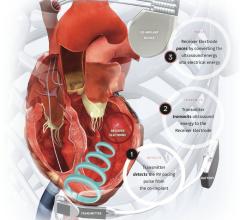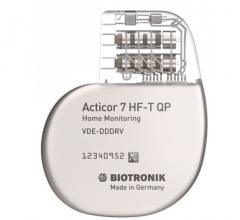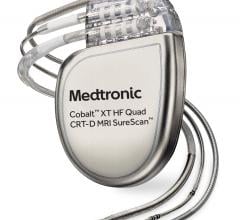
The Anthem RF CRT-P

The Accent RF Pacemaker
Jul y 21, 2009 – St. Jude Medical Inc. today said the FDA cleared its Accent RF pacemaker and Anthem RF CRT-P (cardiac resynchronization therapy pacemaker). The company also announced FDA and European CE mark approval of version 4.0 of the Merlin.net Patient Care Network (PCN), which supports the Accent RF and Anthem RF devices.
The Accent and Anthem product family features RF telemetry that enables secure, wireless communication between the implanted device and the programmer used by the clinician or a home monitor, making it the first integrated system of pacing devices with wireless telemetry from implant through follow-up. Wireless communication is used when clinicians implant the device and during follow-up appointments, which can be performed in the clinic or via remote monitoring from the patient’s home.
Patient device follow-up can be scheduled to take place automatically, in a hands-free manner, with no patient interaction required. Information from the device is then captured by the Merlin@home transmitter, and becomes available for viewing by the clinician via Merlin.net PCN. In addition to fast access to device data, Merlin.net PCN also allows physicians to compile a more complete patient record, by easily transferring cardiac device data into electronic health records (EHRs), the company said.
The Accent RF pacemaker and Anthem RF CRT-P have several features that simplify patient management. These features include AT/AF Alerts, AutoCapture Pacing System technology that measures the heart’s reaction to pacing beat-by-beat, and the VIP algorithm that enables the heart’s intrinsic rhythm to prevail when appropriate, thereby reducing unnecessary ventricular pacing.
The AT/AF Alert feature helps to better assist physicians in accurately diagnosing and managing patients with fast rates in the heart’s upper chambers, called atria. This feature is designed to notify physicians when a rapid atrial rate, atrial tachycardia or atrial fibrillation (AT/AF), exceeds a programmed value or occurs over an extended period of time. The devices also can be programmed to notify the patient of AT/AF episodes, as well as device- and lead-related issues, through a two-tone audible alert. In addition, the patient’s clinic can be informed through the home monitoring system. These features will allow the physician to more proactively manage patients’ atrial arrhythmias, such as AF.
“The automatic alerts provided by the RF telemetry built in to the Accent RF and Anthem RF devices enhance my ability to manage patients’ heart conditions and disease progression, something that is particularly important for patients with heart failure or other comorbidities,” said Steven Greenberg, M.D., coordinator of the Arrhythmia and Pacemaker Center at St. Francis Hospital in Roslyn, N.Y. “Rather than checking the device a few times a year, the daily alerts allow me to know about important changes in my patient’s condition or device functions so I can act more quickly in addressing any issues.”
AutoCapture Pacing System technology allows the devices to be programmed to automatically monitor and adjust the level of electrical energy needed for stimulating the patient’s heart, confirming that the heart is responding to the stimulation. This feature provides the dual benefit of added safety for the patient and increased efficiency for physicians, as vital threshold tests are performed automatically.
The St. Jude Medical Ventricular Intrinsic Preference (VIP) algorithm allows the device to monitor the heart beat-by-beat and provide pacing only when necessary. Allowing the patient’s natural heart rhythm to work on its own when possible has been shown to benefit overall heart health.
With the combination of advanced features and efficiencies provided by the company’s consolidated Unity device platform, the Accent RF pacemaker and Anthem RF CRT-P offer significantly improved battery longevity and an industry-leading seven-year warranty, St. Jude Medical said.
For more information: www.sjm.com


 July 21, 2025
July 21, 2025 









